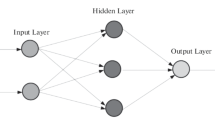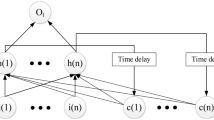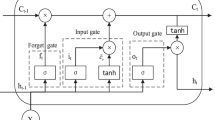Abstract
Accurate and reliable runoff forecasting plays an increasingly important role in the optimal management of water resources. To improve the prediction accuracy, a hybrid model based on variational mode decomposition (VMD) and deep neural networks (DNN), referred to as VMD-DNN, is proposed to perform daily runoff forecasting. First, VMD is applied to decompose the original runoff series into multiple intrinsic mode functions (IMFs), each with a relatively local frequency range. Second, predicted models of decomposed IMFs are established by learning the deep feature values of the DNN. Finally, the ensemble forecasting result is formulated by summing the prediction sub-results of the modelled IMFs. The proposed model is demonstrated using daily runoff series data from the Zhangjiashan Hydrological Station in Jing River, China. To fully illustrate the feasibility and superiority of this approach, the VMD-DNN hybrid model was compared with EMD-DNN, EEMD-DNN, and multi-scale feature extraction -based VMD-DNN, EMD-DNN and EEMD-DNN. The results reveal that the proposed hybrid VMD-DNN model produces the best performance based on the Nash-Sutcliffe efficiency (NSE = 0.95), root mean square error (RMSE = 9.92) and mean absolute error (MAE = 3.82) values. Thus the proposed hybrid VMD-DNN model is a promising new method for daily runoff forecasting.













Similar content being viewed by others
References
Ali M, Khan A, Rehman NU (2018) Hybrid multiscale wind speed forecasting based on variational mode decomposition. Int Trans Electr Energ Syst 28(1):e2466
Bai Y, Chen ZQ, Xie JJ, Li C (2016) Daily reservoir inflow forecasting using multiscale deep feature learning with hybrid models. J Hydrol 532:193–206
Bengio Y, Courville A, Vincent P (2013) Representation learning: a review and new perspectives. IEEE Trans Pattern Anal Mach Intell 35(8):1798–1828
Bengio Y, Lamblin P, Popovici D, Larochelle H (2007) Greedy layer-wise training of deep networks. Adv Neural Inf Proces Syst 19:153–160
Box GE, Jenkins GM, Reinsel GC, Ljung GM (2015) Time Series Analysis: Forecasting and Control. John Wiley & Sons
Chellali F, Khellaf A, Belouchrani A (2010) Wavelet spectral analysis of the temperature and wind speed data at Adrar. Algeria Renew Energ 35(6):1214–1219
Cheng CT, Niu WJ, Feng ZK, Shen JJ, Chau KW (2015) Daily reservoir runoff forecasting method using artificial neural network based on quantum-behaved particle swarm optimization. Water 7(8):4232–4246
Cho KH, Ilin A, Raiko T (2011) Improved learning of Gaussian-Bernoulli restricted Boltzmann machines. Lect Notes Comput Sci 6791:10–17
Ciresan DC, Meier U, Gambardella LM, Schmidhuber J (2010) Deep big simple neural nets excel on handwritten digit recognition. Neural Comput 22(12):3207–3220
Citakoglu H, Cobaner M, Haktanir T, Kisi O (2014) Estimation of long-term monthly mean reference evapotranspiration in Turkey. Water Resour Manag 28(1):99–113
Collobert R, Weston J (2008) A unified architecture for natural language processing: deep neural networks with multitask learning. Proceedings of the 25th international conference on. Mach Learn:160–167
Dabuechies I (1990) The wavelet transform, time-frequency localization and signal analysis. IEEE Trans Inf Theory 36:6–7
Di CL, Yang XH, Wang XC (2014) A four-stage hybrid model for hydrological time series forecasting. PLoS One 9(8):e104663
Dragomiretskiy K, Zosso D (2014) Variational mode decomposition. IEEE Trans Signal Process 62(3):531–544
He Y, Wang F, Mu X, Yan H, Zhao G (2015) An assessment of human versus climatic impacts on Jing River Basin, Loess Plateau, China. Advances in Meteorology. Article ID 478739
Hinton G, Deng L, Yu D, Dahl GE, Mohamed AR, Jaitly N, Senior A, Vanhoucke V, Nguyen P, Sainath TN, Kingsbury B (2012) Deep neural networks for acoustic modeling in speech recognition. IEEE Sigrurl Processing Magazine 29(6):82–97
Hinton GE (2002) Training products of experts by minimizing contrastive divergence. Neural Comput 14(8):1771–1800
Hinton GE, Osindero S, Teh YW (2006) A fast learning algorithm for deep belief nets. Neural Comput 18(7):1527–1554
Huang NE, Shen Z, Long SR, Wu MC, Shih HH, Zheng QA, Yen NC, Tung CC, Liu HH (1998) The empirical mode decomposition and the Hilbert spectrum for nonlinear and non-stationary time series analysis. Proc R Soc Lond A 454:903–995
Huang SZ, Chang JX, Huang Q, Chen YT (2014) Monthly streamflow prediction using modified EMD-based support vector machine. J Hydrol 511:764–775
Kisi O, Cimen M (2012) Precipitation forecasting by using wavelet-support vector machine conjunction model. Eng Appl Artif Intell 25:783–792
Koza JR (1992) Genetic Programming: On the programming of computers by means of natural selection. MIT Press 33:69–73
Krizhevsky A, Sutskever I, Hinton GE (2017) Imagenet classification with deep convolutional neural networks. Commun ACM 60(6):84–90
Lahmiri S (2015) Long memory in international financial markets trends and short movements during 2008 financial crisis based on variational mode decomposition and detrended fluctuation analysis. Phys A, Stat Mech Appl 437:130–138
Lahmiri S, Boukadoum M (2015) Physiological signal denoising with variational mode decomposition and weighted reconstruction after DWT thresholding. In Proceedings of the IEEE International Symposium on Circuits and Systems (ISCAS), Lisbon, Portugal pp 806–809
Li C, Bai Y, Zeng B (2016) Deep feature learning architectures for daily reservoir inflow forecasting. Water Resour Manag 30(14):5145–5161
Lin GF, Chen GR, Huang PY, Chou YC (2009) Support vector machine-based models for hourly reservoir inflow forecasting during typhoon-warning periods. J Hydrol 372(1–4):17–29
Liu H, Mi XW, Li YF (2018) Smart multi-step deep learning model for wind speed forecasting based on variational mode decomposition, singular spectrum analysis. LSTM network and ELM Energy Convers Manage 159:54–64
Moghaddamnia A, Ghafari M, Piri J, Amin S, Han D (2009) Evaporation estimation using artificial nctworlcs and adaptive ncuro-fuzzy inference system techniques. Adv Water Resour 32:88–97
Mohamed AR, Dahl GE, Hinton G (2012) Acoustic modeling using deep belief networks. IEEE Trans on Audio Speech Language Process 20(1):12–22
Naik J, Dash S, Dash PK, Bisoi R (2018) Short term wind power forecasting using hybrid Variational mode decomposition and multi-kernel regularized Pseudo inverse neural network. Renew Energy 118:180–212
Nayak PC, Sudheer KP, Rangan DM, Ramasastri KS (2004) A neuro-fuzzy computing technique for modeling hydrological time series. J Hydrol 291(1):52–66
Okkan U, Serbes ZA (2012) Rainfall-runoff modeling using least squares support vector machines. Environmetrics 23(6):549–564
Ran DC, Liu B, Wang H, Luo QH, Ma Y (2006) Soil and water conservation measures and their benefits in runoff and sediment reductions of typical tributary in the middle of Yellow River. The Yellow River Water Conservancy Press, Zhengzhou, China
Sattari MT, Yurekli K, Pal M (2012) Performance evaluation of artificial neural network approaches in forecasting reservoir inflow. Appl Math Model 36(6):2649–2657
Toth E, Brath A, Montanari A (2000) Comparison of short-term rainfall prediction models for real-time flood forecasting. J Hydrol 239(1):132–147
Wang WC, Chau KW, Cheng CT, Qiu L (2009) A comparison of performance of several artificial intelligence methods for forecasting monthly discharge time series. J Hydrol 374(3):294–306
Wang WC, Xu DM, Chau KW, Chen SY (2013) Improved annual rainfall-runoff forecasting using PSO-SVM model based on EEMD. J Hydroinf 15(4):1377–1390
Wang ZY, Qiu J, Li FF (2018) Hybrid models combining EMD/EEMD and ARIMA for Long-term streamflow forecasting. Water 10(7):853
Wu ZH, Huang NE (2009) Ensemble empirical mode decompostion: a noise-assisted data analysis method. Adv Adaptive Data Anal 1(1):1–41
Zhang J, Cheng CT, Liao SL, Wu XY, Shen JJ (2009) Daily reservoir inflow forecasting combining QPF into ANNs model. Hydro Earth Syst Sci 6:121–150
Acknowledgments
This work was supported by the National Key R&D Program of China under Grant No. 2016YFC0401409 and the National Natural Science Foundation of China under Grant Nos. 51679186 and 51679188.
Author information
Authors and Affiliations
Corresponding author
Ethics declarations
Conflict of Interest
The authors declare no conflicts of interest.
Additional information
Publisher’s Note
Springer Nature remains neutral with regard to jurisdictional claims in published maps and institutional affiliations.
Rights and permissions
About this article
Cite this article
He, X., Luo, J., Zuo, G. et al. Daily Runoff Forecasting Using a Hybrid Model Based on Variational Mode Decomposition and Deep Neural Networks. Water Resour Manage 33, 1571–1590 (2019). https://doi.org/10.1007/s11269-019-2183-x
Received:
Accepted:
Published:
Issue Date:
DOI: https://doi.org/10.1007/s11269-019-2183-x




